Holly Fern
Holly fern is a handsome, cold-hardy plant that deserves more use in Central Florida landscapes. This Asian fern (Cyrtomium falcatum) grows up to 30 inches tall and 48 inches wide in the moderate-to-deep shade on moist, heavily mulched sites, where it slowly forms attractive clumps.
It’s called holly fern due to the glossy, dark-green, triangular leaflets carried on arching stems.
When installing holly ferns, space them about 30 inches apart for a groundcover, or combine them with other shade plants such as bromeliads, lady palms, and cast-iron plants.
In addition to shade, holly ferns, which aren’t notably drought tolerant, require occasional irrigation during dry periods to prosper.
Fertilizer is generally unnecessary, and pests, including caterpillars and grasshoppers, rarely cause serious damage.
Note: These plants and other shade-dependent species should be installed only where they’ll receive shade year-round.
Accordingly, consider seasonal movements of the sun and whether the trees providing shade is evergreen or deciduous.
Cyrtomium Falcatum – Holly Fern Origins
Most folks in the South know holly fern. It is as well suited to the South as live oaks and magnolias. However, since it hails from Asia, South Africa, and Polynesia, we cannot claim it as one of our natives.
Hardy from Zones 6-10, it can withstand temperatures as low as 14 degrees F. Holly fern (Cyrtomium falcatum) is an excellent choice for a potted specimen in a shaded corner.
It tucks nicely into pockets of soil in rock gardens and is a good groundcover in shady or woodland locations. It makes a wonderful understory plant beneath old reclaimed plants like camellia, sweet olive, hollies, and other large shrubs with lower branches cut off.
Holly fern is exceedingly well-mannered in the garden. The growth rate is moderate, and plants do not usually need to be divided. Old established clumps can be divided if desired.
Lustrous stiff, erect to arching fronds radiate from the center of the plants to form attractive clumps. Individual fronds grow from 20 to 30 inches long and up to 8 inches wide.
Growing Holly Fern
Plants grow 2-3 feet high and spread out to about 3 feet wide. Leaves of holly fern are thicker than other ferns, so it stands up to coastal breezes without tattering. This characteristic also makes it very useful for those who garden in salt air or use a saline water supply.
Partial to full shade suits it best, and it will truly shine in loose, fertile, moist soil with a high organic matter content. Follow a timely watering schedule during the first growing season to establish a deep, extensive root system.
Fertilize in late winter with a common all-purpose garden fertilizer. Appearance is enhanced if browning fronds are removed from time to time. Winter-damaged fronds can be cut back before new spring growth begins.
Like some other ferns, holly fern is attractive in floral designs. However, as with other ferns, caution is advised. Once I made an extraordinary design for my niece’s wedding. I chose holly fern for the line material and wired it into an attractive S-curve.
I chose a suitably tall, slender container and then added flowers to follow the curve and disguise wires I had used to hold the ferns in place. It was quite beautiful, and everyone made admiring comments.
I became concerned, however, when I noticed that the linen cloth underneath the design seemed to be getting dirty. I brushed at it, and to my dismay, it smeared and messed up the beautifully starched and ironed tablecloth.
I had forgotten that ferns have sori (clusters of spore cases) on the backs of their leaves. When the spores are ripe, the sori shatter, and spores are scattered from here to kingdom come.
Well, the kingdom came right on top of my table. Chalk it up to experience. Now when I use ferns in designs, I check the back of the leaves. If the sori are dark, they are about ready to pop. As long as they are green, they can safely be used in floral designs.
Cultivars include Butterfieldii, with deeply serrated leaf margins; Compactum, with leaves shorter than the species; and Rochefordianum, which has holly-like leaves with coarsely fringed margins.
Look in area garden centers for this useful plant. Buy several and plant them in broad sweeps or cover the ground underneath a shady tree.
However, you choose to use holly fern to add grace and beauty to its place in the landscape.
Special features: The thick-leaved holly fern can take indoor or patio abuse of forgotten waterings and skipped feedings. Display in a hanging basket or grow a large pot of overflowing foliage. Periodically groom to remove yellowing leaves and dust.


























